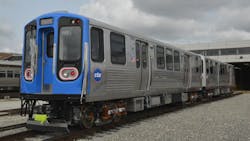CTA proposes $2.16 billion operating budget
The Chicago Transit Authority’s (CTA) proposed $2.16 billion operating budget keeps fares at current levels, delivers more bus and rail service hours than provided in 2019 and fuels new and ongoing investments to either expand or modernize existing infrastructure while also evolving current systems to meet modern transit riding needs.
The proposed spending budget reflects an 8.1 percent increase (or $161.1 million) over the previous year’s budget and supports CTA’s ongoing workforce initiatives for hiring, training and retaining key operations personnel to provide service levels that exceed 2019/pre-pandemic levels.
The proposed operating budget also offers opportunities for the CTA to continue to innovate and seek out new measures for improving key areas of the transit riding experience, including enhanced customer communications, improved transit connections and services and ongoing investments to provide cleaner, brighter, safer, more modern and accessible facilities.
“Our workforce of 10,000 has put forth an impressive effort to ensure CTA either reached its goals or is on the path to do so by the end of the year — including increasing ridership, restoring our service levels to pre-pandemic levels and making significant progress in advancing system improvements and I am truly excited about what’s in store for 2025, as we build on this momentum and look to add even more service, improve accessibility, begin work to expand our system and continue our investments in our personnel, infrastructure and fleets,” said CTA President Dorval R. Carter, Jr.
Progress made in 2024
At the start of 2024, CTA set-out to address three major goals:
- Continue building ridership
- Strengthen the workforce
- Restore bus and service levels to pre-COVID-19 pandemic levels
- Ridership: CTA says numerous ridership milestones have been achieved so far in 2024, including system-wide average daily ridership reaching one million rides in May for the first time since the COVID-19 pandemic. CTA says its ridership growth year-over-year is the second-fastest ridership growth among the largest American transit agencies, reaching 14 percent growth from April through July 2024. Other milestones in 2024 include accruing at least 39 days in which daily bus rides exceeded 600,000, which is up from only four days in 2023. On the rail side, the agency notes Aug. 1, 2024, marked the first time that rail ridership exceeded 500,000 daily rides since the start of the COVID-19 pandemic.
- Bus services: This summer, CTA notes bus operator staffing returned to pre-COVID-19 pandemic levels, which has improved service frequency and reliability. In August, 98.1 percent of bus service was delivered, a marked improvement from the 80.4 percent of bus service delivered in 2022. So far this year, service improvements have been made on 59 bus routes, with pre-COVID-19 pandemic levels being fully restored by December.
- Rail operations: The agency says it is on track to train 200 new rail operators by the end of the year, which will help restore 2019 rail service levels by this November. Efforts made so far have resulted in rail service reliability reaching 96 percent in August – a massive improvement from 71.8 percent rail service delivered in 2022.
The CTA, plus regional transit agencies Metra and Pace Suburban Bus, are facing a post-COVID-19 pandemic fiscal cliff— a $730 million combined budget shortfall expected in Fiscal Year 2026. CTA says the deficit is a direct result of an inadequate state funding formula, passed in 1983, that has been further exacerbated by the ridership and revenue declines caused by the COVID-19 pandemic. While there has been increased public transit funding since 1983, CTA says many of those funding changes have not kept up with the cost of employee wages and pension payments, which required systemwide service cuts in the past to afford.
Despite the financial challenges, the CTA adds it continues to look for ways to operate more efficiently and effectively while also lobbying and appealing elected officials to reimagine how public transit is funded. The agency notes that with a new funding formula and support for transit equity from elected officials, it can make transformational change in terms of how it supports and provides transit service in the Chicago region.
Plans for 2025 and beyond
The CTA’s 2025-2029 Capital Improvement Program—which is separate from the agency’s operating budget—calls for $6.96 billion in projects during the next five years. The budget reflects CTA’s ongoing commitment towards the modernization and improvement of its physical infrastructure—tracks, rail stations, buses and trains, facilities and technologies.
Key capital projects to continue or begin in 2025 include:
- Red and Purple Modernization (RPM) Phase One: Substantial completion of Phase One project work in 2025, which includes the reconstruction of the Lawrence, Argyle, Berwyn and Bryn Mawr Red Line stations and adjacent track structures.
- Red Line Extension: The anticipated start of work to extend the CTA’s busiest rail line to the southern city limits is anticipated in 2025. The transformational project will provide greatly improved transit access and connectivity to the far south side of Chicago.
- All Stations Accessibility Program: In 2025, CTA plans to open six newly accessible stations: Lawrence, Berwyn, Bryn Mawr and Argyle as part of the RPM Phase One Project; Racine as part of the Forest Park Branch Rebuild; and Austin on the Green Line. Approximately $37 million in funding has been secured for systemwide elevator replacement work, which is also expected to begin in 2025.
- Rail and bus fleet modernization: Increased production of the 7000-series, CTA’s newest generation of railcars. Plus, ongoing quarter-life overhauls of the agency’s 5000-series, as well as the continuation of efforts to gradually update the agency’s facilities to support the operation of electric buses.
- Operations control and training facility: Advancement of plans to construct a new facility in the West Garfield Park neighborhood to house the CTA's 24/7 control center, which oversees all bus, rail and power operations, as well as more than 250 employees. The facility will also serve as the primary training center for CTA's workforce of more than 10,000 employees.
